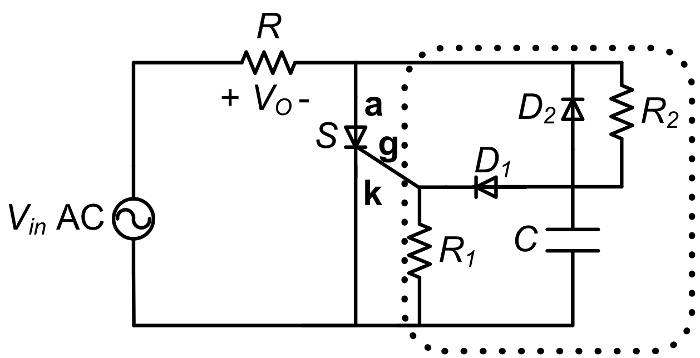Rectificador de tiristores
Visión general
Fuente: Ali Bazzi, Departamento de ingeniería eléctrica, Universidad de Connecticut, Storrs, CT.
Similar a los diodos, tiristores, que rectificadores de silicio controlado (SCRs), también se llama pasan corrientes en una dirección del ánodo al cátodo y bloquean el flujo de corriente en la otra dirección. Sin embargo, paso actual puede ser controlado a través de una "puerta" terminal, que requiere un pulso actual pequeño para activar el tiristor para que pueda empezar a realizar.
Tiristores son dispositivos de cuatro capas, compuesto por alternas capas de tipo n y material tipo p, formando así estructuras PNPN con tres uniones. El tiristor tiene tres terminales; con el ánodo conectado al material tipo p de la estructura PNPN, el cátodo conectado a la capa tipo n, y la puerta conectada a la capa de tipo p más cercana al cátodo.
El objetivo de este experimento es un rectificador de media onda de tiristores controlado en diferentes condiciones y entender cómo diferentes tiempos el puerta pulso afecte la C.C. del voltaje de salida.
Procedimiento
Atención: Durante este experimento, no toque ninguna parte del circuito mientras que energiza. No conecte a tierra la VARIAC.
Para este experimento, el transformador variable (VARIAC) a un obviados de 60 Hz y el pico de 35 V se utiliza como la fuente principal de AC.
1. configuración
- Antes de comenzar, conectar la sonda diferencial a un alcance canal.
- Programar el botón de la atenuación diferencial sonda 1/20 (o 20 X).
Resultados
La forma de onda de voltaje de entrada CA es picado hasta el ángulo de disparo. Las relaciones importantes de la media de voltaje de salida y ángulos de diferentes rectificadores SCR con entrada Venla leña = V0 cos (ωt) son:
• Única SCR y R de la carga: <a> =V0[1+cos(α)] / (2π) (2)
Aplicación y resumen
SCR era comunes en mayores fuentes de alimentación de DC que requieren un variable DC voltaje de salida de CA de entrada. Mediante el ajuste de la resistencia R2 en el circuito anterior, es posible ajustar la media ay por consiguiente un ajustable DC alimentación resultados. El SCRs no son comunes más en fuentes de alimentación DC como que cambiar a la frecuencia de línea de entrada (típicamente 50 o 60 Hz) y nuevo poder cambiar fuentes en 10 s o 100 s de kHz que hace filtra...
Saltar a...
Vídeos de esta colección:

Now Playing
Rectificador de tiristores
Electrical Engineering
17.6K Vistas

Precauciones de seguridad eléctrica y equipamiento
Electrical Engineering
144.8K Vistas

Caracterización de componentes magnéticos
Electrical Engineering
15.1K Vistas

Introducción a la placa de polos de potencia
Electrical Engineering
12.5K Vistas

Convertidor DC/DC
Electrical Engineering
57.1K Vistas

Convertidor Buck DC/DC
Electrical Engineering
21.2K Vistas

Convertidor de retroceso
Electrical Engineering
13.3K Vistas

Transformadores monofásicos
Electrical Engineering
20.2K Vistas

Rectificadores monofásicos
Electrical Engineering
23.6K Vistas

Inversor monofásico
Electrical Engineering
18.0K Vistas

Motores de corriente continua
Electrical Engineering
23.5K Vistas

Caracterización de motores de inducción de CA
Electrical Engineering
11.7K Vistas

Máquina de inducción de CA alimentada por VFD
Electrical Engineering
7.0K Vistas

Sincronización de máquinas de CA
Electrical Engineering
21.6K Vistas

Caracterización de máquinas sincrónicas de CA
Electrical Engineering
14.3K Vistas
ACERCA DE JoVE
Copyright © 2025 MyJoVE Corporation. Todos los derechos reservados
